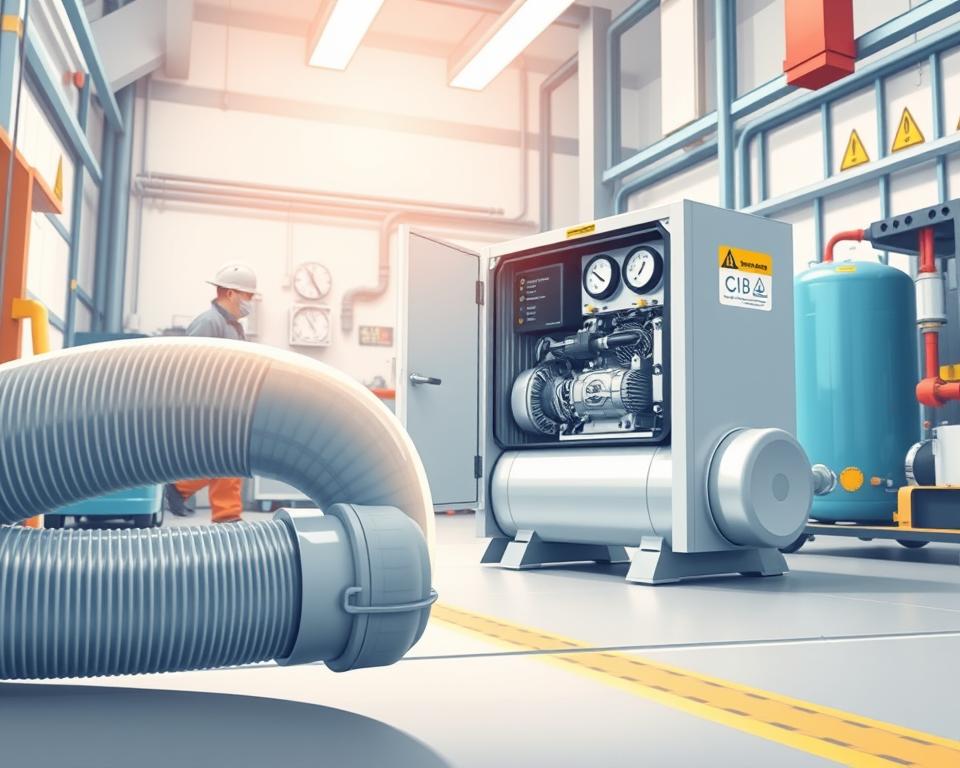PVC Pipe for Air Compressor Lines: Your Complete Guide
You might be surprised to learn that a failure in a compressed air system can unleash power on par with dynamite. Countless operations remain oblivious to the risks of certain piping systems they employ. Read on to discover why PVC for air lines choices demand top-tier safety.
Even as interest rises, OSHA bans these materials for above-ground compressed air. Repeated contact with compressor oil and thermal cycling makes them brittle, causing explosive failures. Those so-called safe pressure limits don’t eliminate explosion risk.
For reliable alternatives, Installation Parts Supply offers durable solutions like aluminum. Investing in proper materials avoids costly fines and keeps workplaces secure. Here’s how to assemble a risk-free system.

Main Points
- Explosion danger leads OSHA to outlaw some pipe materials.
- Temperature changes can halve pressure ratings.
- Material becomes brittle with age, upping rupture chances.
- Aluminum piping offers a safer alternative.
- Proper investment prevents costly fines and accidents.
Why PVC Pipe Is Dangerous for Compressed Air Systems
All major brands advise against certain plastics in compressed air. A breach in a pressurized air line unleashes explosive power, unlike water. This makes material choice critical for safety.
- Brittleness: Below-freezing conditions render PVC dangerously brittle.
- Adhesive failures: Oil contamination and heat cycles break down glue bonds.
- Misleading ratings: Ratings halve by 110°F, a common shop temperature.
OSHA cites a $110,000 fine after a facility’s piping shattered, injuring workers. Don’t forget, compression heat cuts into rated safety margins.
“Above-ground use of certain plastics for compressed air violates OSHA standards due to explosion risks.”
Steel and aluminum curve under stress instead of shattering. Fragments from PVC blasts can hurl past 50 feet, embedding dangerously.
Daily heat and cold cycles in a workshop degrade plastics rapidly. A decade’s UV and chemical attack weakens plastic, so small leaks too often balloon into disasters.
Recommended Piping Materials for Compressed Air
Modern aluminum systems beat old-school piping on both safety and performance. With 90% fewer leaks than black pipe, they’re a top choice for modern facilities. Their lightweight design and corrosion resistance make them ideal for long-term use.
Threadless modular aluminum assemblies speed assembly. Installation Parts Supply stocks ready-to-snap aluminum modules. A car plant saw a 40% drop in labor expenses after aluminum installation.
- Copper: Ideal in sterile environments for its germ-killing copper surface. Requires soldering expertise.
- Stainless Steel: In seaside shops, stainless steel won’t corrode.
- ABS/HDPE: Chemical-resistant for labs and factories handling solvents.
“Our aluminum retrofit reduced energy waste by 15%—paying for itself in 18 months.”
Torque matters. Cracks from overtightening and leaks from under-tightening are common. Stick to recommended 25–30 ft-lb torque for aluminum.
For food-grade applications, NSF-certified options ensure air purity. Always match materials to your environment’s demands.
Material Selection Guide for Compressed Air
Selecting the best material for your setup requires balancing cost, safety, and efficiency. A Midwest factory saved $12,000 annually by switching to leak-resistant aluminum. Here’s how to make the right choice.
| Material | Cost (per ft) | Maintenance | ROI Time |
|---|---|---|---|
| Aluminum | $8.50 | Low | 18 months |
| Black Pipe | $5.00 | High | N/A |
| Copper | $10.20 | Medium | 24 months |
Watch your operating temperatures. Plastics fail under 32°F; aluminum works from -40°F to 200°F. For chemical-heavy environments, stainless steel resists solvents.
Pro Tip: Calculate ROI using CFM loss formulas. Don’t let 10% leakage cost you $3,500 a year.
- Match PSI ratings to your compressor’s output.
- Keep records of inspections and tests to satisfy OSHA.
- Request a free system audit from Installation Parts Supply.
“Our aluminum retrofit cut energy waste by 15%—paying for itself in 18 months.”
Hire pros for big installs to guarantee airtight connections. Don’t forget to read the fine print on warranty lengths.
Bringing It All Together
Safety outweighs sticker price in compressed-air piping. Ninety-two percent of pipe failures occur in aging lines, frequently causing injuries. With 99.8% uptime, aluminum is the clear long-term choice.
Don’t forget:
- Never use pipes that can fragment violently.
- Opt for corrosion-resistant metals like aluminum or stainless steel.
- Failing to comply can cost you big in fines and claims.
Upgrade now and secure your workplace. Installation Parts Supply provides same-day quotes and limited-time discounts on starter kits. Access a complimentary maintenance template or request urgent replacements.
Make safety your piping priority—act today.